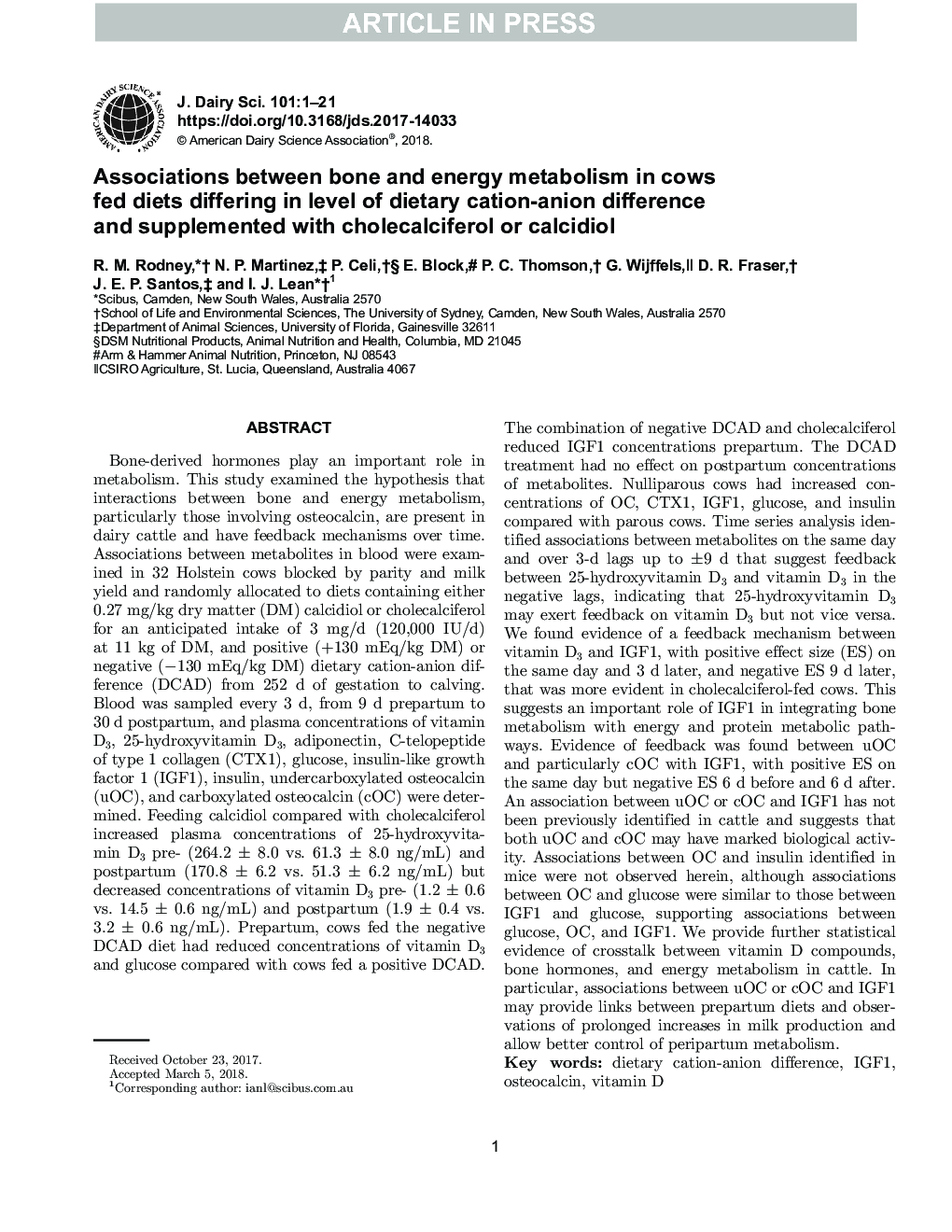| کد مقاله | کد نشریه | سال انتشار | مقاله انگلیسی | نسخه تمام متن |
|---|---|---|---|---|
| 8501118 | 1553838 | 2018 | 21 صفحه PDF | دانلود رایگان |
عنوان انگلیسی مقاله ISI
Associations between bone and energy metabolism in cows fed diets differing in level of dietary cation-anion difference and supplemented with cholecalciferol or calcidiol
ترجمه فارسی عنوان
ارتباط بین متابولیسم استخوانی و انرژی در گاوهای تغذیه شده با رژیم های غذایی متفاوت در سطوح مختلف کاتیون های موجود در رژیم غذایی و با کلکلسیفرول و کلسیدیدول
دانلود مقاله + سفارش ترجمه
دانلود مقاله ISI انگلیسی
رایگان برای ایرانیان
کلمات کلیدی
موضوعات مرتبط
علوم زیستی و بیوفناوری
علوم کشاورزی و بیولوژیک
علوم دامی و جانورشناسی
چکیده انگلیسی
Bone-derived hormones play an important role in metabolism. This study examined the hypothesis that interactions between bone and energy metabolism, particularly those involving osteocalcin, are present in dairy cattle and have feedback mechanisms over time. Associations between metabolites in blood were examined in 32 Holstein cows blocked by parity and milk yield and randomly allocated to diets containing either 0.27 mg/kg dry matter (DM) calcidiol or cholecalciferol for an anticipated intake of 3 mg/d (120,000 IU/d) at 11 kg of DM, and positive (+130 mEq/kg DM) or negative (â130 mEq/kg DM) dietary cation-anion difference (DCAD) from 252 d of gestation to calving. Blood was sampled every 3 d, from 9 d prepartum to 30 d postpartum, and plasma concentrations of vitamin D3, 25-hydroxyvitamin D3, adiponectin, C-telopeptide of type 1 collagen (CTX1), glucose, insulin-like growth factor 1 (IGF1), insulin, undercarboxylated osteocalcin (uOC), and carboxylated osteocalcin (cOC) were determined. Feeding calcidiol compared with cholecalciferol increased plasma concentrations of 25-hydroxyvitamin D3 pre- (264.2 ± 8.0 vs. 61.3 ± 8.0 ng/mL) and postpartum (170.8 ± 6.2 vs. 51.3 ± 6.2 ng/mL) but decreased concentrations of vitamin D3 pre- (1.2 ± 0.6 vs. 14.5 ± 0.6 ng/mL) and postpartum (1.9 ± 0.4 vs. 3.2 ± 0.6 ng/mL). Prepartum, cows fed the negative DCAD diet had reduced concentrations of vitamin D3 and glucose compared with cows fed a positive DCAD. The combination of negative DCAD and cholecalciferol reduced IGF1 concentrations prepartum. The DCAD treatment had no effect on postpartum concentrations of metabolites. Nulliparous cows had increased concentrations of OC, CTX1, IGF1, glucose, and insulin compared with parous cows. Time series analysis identified associations between metabolites on the same day and over 3-d lags up to ±9 d that suggest feedback between 25-hydroxyvitamin D3 and vitamin D3 in the negative lags, indicating that 25-hydroxyvitamin D3 may exert feedback on vitamin D3 but not vice versa. We found evidence of a feedback mechanism between vitamin D3 and IGF1, with positive effect size (ES) on the same day and 3 d later, and negative ES 9 d later, that was more evident in cholecalciferol-fed cows. This suggests an important role of IGF1 in integrating bone metabolism with energy and protein metabolic pathways. Evidence of feedback was found between uOC and particularly cOC with IGF1, with positive ES on the same day but negative ES 6 d before and 6 d after. An association between uOC or cOC and IGF1 has not been previously identified in cattle and suggests that both uOC and cOC may have marked biological activity. Associations between OC and insulin identified in mice were not observed herein, although associations between OC and glucose were similar to those between IGF1 and glucose, supporting associations between glucose, OC, and IGF1. We provide further statistical evidence of crosstalk between vitamin D compounds, bone hormones, and energy metabolism in cattle. In particular, associations between uOC or cOC and IGF1 may provide links between prepartum diets and observations of prolonged increases in milk production and allow better control of peripartum metabolism.
ناشر
Database: Elsevier - ScienceDirect (ساینس دایرکت)
Journal: Journal of Dairy Science - Volume 101, Issue 7, July 2018, Pages 6581-6601
Journal: Journal of Dairy Science - Volume 101, Issue 7, July 2018, Pages 6581-6601
نویسندگان
R.M. Rodney, N.P. Martinez, P. Celi, E. Block, P.C. Thomson, G. Wijffels, D.R. Fraser, J.E.P. Santos, I.J. Lean,
